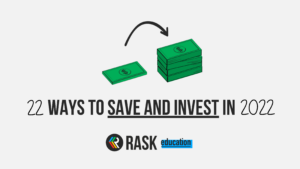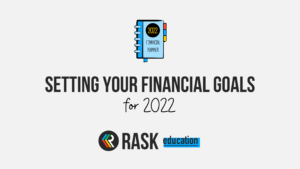For many Australians, investing is a daunting activity to get started with, however, micro-investing apps like Raiz Invest (which has over 200,000 active Aussie users) have broken down many of the traditional barriers to investing for beginners.
Starting with just $5 you can get your first taste of being an owner in our global economy rather than just a consumer, which is pretty exciting! In this article, I’ll dive into what micro-investing is, how it works, pros and cons, apps in Australia and what your other options are.
What is micro-investing and how does it work?
Micro-investing is a way to get started investing with much less than the typical $500 minimum purchase mandated by most Australian brokers. It focuses on getting you started investing with a small amount and making regular contributions over time, with the wheels of compound interest working in your favour over the long run.
Some micro-investing apps (like Raiz Invest or Spaceship) allow you to invest directly into a diversified portfolio of shares or ETFs from just $5 and others are more like a broker, where you can buy a single or fractional share or ETF (like CommSec Pocket or Stake).
Other features offered by some micro-investing apps to keep an eye on include round-up contributions, auto-investments and regular contribution plans via direct debit, which are very helpful tools for new investors looking to invest on a more regular basis.
And hey – we actually just interviewed Raiz Invest CEO Brendan Malone on the basics of micro-investing, so feel free to tune into that episode on The Australian Finance Podcast!
Pros v Cons of micro-investing to consider
When it comes to micro-investing apps, you’re generally not comparing apples with apples, so there’s a number of factors you should investigate to decide if the product is right for your investing needs.
Quick and easy to get started
One of the positives about micro-investing apps is that they’re very easy to use. If you’re just looking to dip you toe into the water while you’re learning about investing, they might be a great tool for you to start with as you learn the ropes. Many of them allow you to open an account via the app on the spot, and invest your first few dollars almost instantly (if the market’s open)!
Investigate the fees
When investing very small amounts, sometimes the fees can outweigh the benefits of investing and it may be a better idea to keep saving until you can invest a larger amount. Make sure you look into the management/monthly subscription fees, brokerage/transaction fees, indirect costs and account opening/closure costs, which are often found in the product disclosure statement (PDS).
Is it legit?
Although our financial services industry for retail investors like you and I is highly regulated, I’d always recommend doing your own due diligence and getting comfortable with the structure of the investment product.
The PDS should have details about where your assets are held, and I’d recommend searching for the word ‘custodian’, as micro-investing apps will often use a 3rd-party to hold your assets and keep them separate from their own funds. In the event of something happening to one of these companies, they may be able to appoint a new manager or liquidate the holdings, so it’s a good idea to know who’s involved.
If you feel like scrolling down to read the fine print at the bottom of the page, have a look if the company has an Australian Financial Services License (AFSL), which is a government license to provide financial services to consumers in Australia.
If you’d like to do your own research on a micro-investing app, here are some of the questions that I’d be asking to further understand the structure:
- Where will my assets be held? Do I get my own holder identification number (HIN), are my holdings beneficially held or do I receive units in a fund?
- Do you use an external custodian and who is it?
- Are you registered to provided financial services in Australia? Do you have an AFSL?
- What would happen in the event your company goes under?
Can you lose money?
Just because you’re only investing a small amount of money doesn’t take away the risks of investing. Micro-investing apps still expose you to the same risks that you’d get investing in those assets directly, but a 20% decline on $10 will feel very different to the same decline on $1,000.
Do your research and make sure you know where you’re putting your money. If you’re keen to learn more, take our free ETF and share investing courses for beginners, which explain some of these risks in more detail.
Do I get dividends?
Although micro-investing apps may have less flexibility when it comes to dividends, it’s worth investigating whether they’re automatically invested back into your portfolio or paid out to your nominated bank account. Not every company or investment pays a dividend, so I’d definitely check on each individual providers website and get in touch with them, if receiving dividends is important factor for you.
Micro-investing apps in Australia
Although some of these are categorised as ‘fractional investing apps’ rather than micro-investing apps, I thought I’d round up the current options you have in Australia, for getting started investing with smaller amounts of money.
- Raiz Invest – micro-investing in a choice of 7 diversified ETF portfolios
- Spaceship – micro-investing with two different portfolios
- CommSec Pocket – invest in a selection of 7 individual ASX ETFs (individual HIN)
- Superhero – $100 minimum ASX investing (group HIN model)
- Goodments – fractional US investing with ethical filters
- Stake – fractional investing in US shares/ETFs
What are your other investing options?
There’s a lot of choice out there nowadays when it comes to investing, but most people fall into the shares/ETFs/managed funds and/or property buckets. If you’re keen to learn more about investing directly into shares, ETFs and other products we’ve got you covered. Check out our free educational courses over here and The Australian Finance Podcast!
Resources
- Check out previous episodes of The Australian Finance Podcast, including Ep. 8. ETFs, Managed Funds & Index Funds, Ep. 21. How To Pick & Choose ASX ETFs & Ep. 64. How to build an ETF portfolio, with Kris Walesby of ETF Securities
- Raiz – The #1 Investment App
- Micro-investing and fractional trading apps for Australians in 2020
- Beginner’s ETF Investing Course



